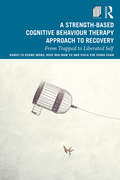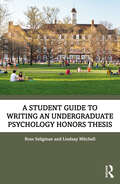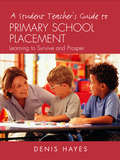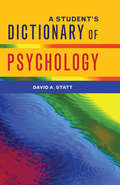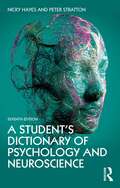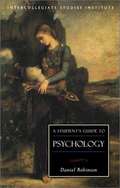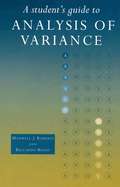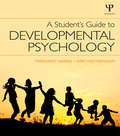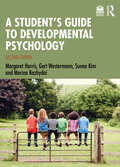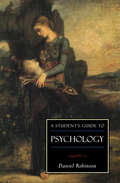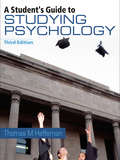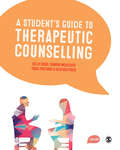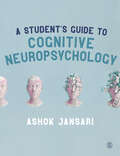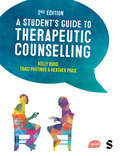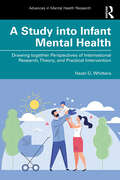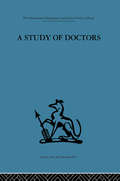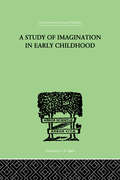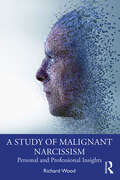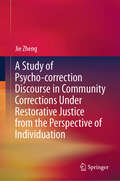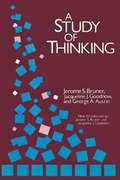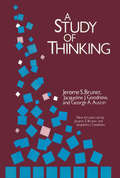- Table View
- List View
A Strength-Based CBT Approach to Recovery: From Trapped to Liberated Self
by Daniel Fu Wong Rose Wai Yu Viola Yuk ChanThis is the first practice-oriented book to provide professionals with a clear and practical guide in delivering strength-based recovery-oriented CBT intervention. Essentially, strength-based CBT moves away from a deficit and rehabilitation model and offers a person with mental illness a sense of renewed hope and meaning of life. With plenty of case illustrations, the book integrates the recovery model and cognitive-behaviour approaches and provides readers with a theoretical understanding of the recovery process and how various cognitive-behaviour strategies can be skilfully applied to different stages of the recovery process. It is written for professionals such as psychiatrists, psychologists, social workers, occupational therapists and nurses in the mental health fields. Step-by-step illustrations of the use of the various cognitive behavioural strategies and worksheets are provided throughout the book.
A Student Guide to Writing an Undergraduate Psychology Honors Thesis
by Ross Seligman Lindsay MitchellA Student Guide to Writing an Undergraduate Psychology Honors Thesis takes students through the entire process of creating a full-scale research project, from selecting a topic, choosing an experimental or correlational design, to writing and presenting their paper. The book offers valuable guidance on developing broader skills like communicating with your supervisor, time management and critical writing skills. Chapters cover topics such as mentor selection, collecting journal articles, gathering and analysing data, and writing a full APA or BPS experimental paper and will orientate and guide psychology students as they navigate the expected components of an honors thesis. Designed for any student that is currently working on an independent research project, A Student Guide to Writing an Undergraduate Psychology Honors Thesis is the perfect companion for those working on their senior honours thesis in psychology.
A Student Guide to Writing an Undergraduate Psychology Honors Thesis
by Ross Seligman Lindsay MitchellA Student Guide to Writing an Undergraduate Psychology Honors Thesis takes students through the entire process of creating a full-scale research project, from selecting a topic, choosing an experimental or correlational design, to writing and presenting their paper. The book offers valuable guidance on developing broader skills like communicating with your supervisor, time management and critical writing skills. Chapters cover topics such as mentor selection, collecting journal articles, gathering and analysing data, and writing a full APA or BPS experimental paper and will orientate and guide psychology students as they navigate the expected components of an honors thesis.Designed for any student that is currently working on an independent research project, A Student Guide to Writing an Undergraduate Psychology Honors Thesis is the perfect companion for those working on their senior honours thesis in psychology.
A Student Teacher's Guide to Primary School Placement: Learning to Survive and Prosper
by Denis HayesSchool experience is the most significant part of learning to be a teacher. It can also be the most confusing, stressful and challenging. Initially, it can be very daunting to walk into someone else's classroom and try to prepare and teach effective lessons to someone else's class.It helps to have a clear idea of what to expect and to know how other people have coped, and in this book, Denis Hayes looks at what life is like for the student-teacher in the classroom. With plenty of down-to-earth and practical advice, he offers strategies for dealing with challenging situations and positive encouragement to help them succeed. The book covers four main areas: principles - summarises the fundamentals of successful teaching placement - provides detailed advice about preparing for, and prospering in, school placements, including case studies of trainee teachers' experiences practice - looks at practical issues in the classroom, including lesson planning, teaching skills, assessment and evaluation, and managing the classroom environment progress - covers applying for jobs and interview strategies, with newly qualified teachers talking about how they managed in their first few months.This text will be invaluable to anyone training to be a primary teacher and about to embark on his or her teaching experience. It will also be a useful resource for teacher mentors and course leaders of BEd, BA (Ed) and PGCE programmes.
A Student's Dictionary of Psychology
by David A. StattA Student's Concise Dictionary of Psychology contains over 1900 definitions from ablation to zygote. There are references to words, phrases and eminent psychological figures and David A. Statt has taken into account the most recent developments in psychology to present the definitions in a clear, instructive and concise manner.This book will be an invaluable source of information for students of psychology and its easily accessible style will make it an indispensable reference tool for those in related professions such as health and social work.
A Student's Dictionary of Psychology and Neuroscience
by Nicky Hayes Peter StrattonAn essential reference work for any student studying psychology for the first time, A Student's Dictionary of Psychology and Neuroscience (Seventh Edition) provides over 2,500 definitions of complex concepts in clear and accessible language alongside helpful diagrams. The dictionary offers comprehensive coverage of the main contemporary terms in psychology and neuroscience. This new edition features updated references which will be particularly relevant to the key areas of neuroscience and neuropsychology and also to recent concepts of psychological significance, such as expanded coverage of research methods, internet psychology, cognitive psychology and social psychology. The dictionary also features end material with useful notes for constructing student essays as well as key references and a list of common abbreviations. Extensive cross-referencing allows students to follow up and identify further details of a given topic, and mini-biographies of key psychologists help to provide relevant context. A Student's Dictionary of Psychology and Neuroscience is the perfect accompaniment for any student newly encountering this fascinating subject, those taking related disciplines in the health or social sciences, or professionals wanting to familiarise themselves with key terms and ideas.
A Student's Guide To Psychology
by Daniel RobinsonThe ISI Guides to the Major Disciplines are reader-friendly introductions to the most important fields of knowledge in the liberal arts. Written by leading scholars for both students and the general public, they will be appreciated by anyone desiring a reliable and informative tour of important subject matter. Each title offers an historical overview of a particular discipline, explains the central ideas of each subject, and evaluates the works of thinkers whose ideas have shaped our world. They will aid students seeking to make better decisions about their course of study as well as general readers who wish to supplement their education. All who treasure the world of ideas and liberal learning will be motivated by these original and stimulating presentations.
A Student's Guide to Analysis of Variance
by Riccardo Russo Maxwell J. RobertsIn the investigation of human behaviour, statistical techniques are employed widely in the social sciences. Whilst introductory statistics courses cover essential techniques, the complexities of behaviour demand that more flexible and comprehensive methods are also employed. Analysis of Variance (ANOVA) has become one of the most common of these and it is therefore essential for both student and researcher to have a thorough understanding of it.A Student's Guide to Analysis of Variance covers a range of statistical techniques associated with ANOVA, including single and multiple factor designs, various follow-up procedures such as post-hoc tests, and how to make sense of interactions. Suggestions on the best use of techniques and advice on how to avoid the pitfalls are included, along with guidelines on the writing of formal reports.Introductory level topics such as standard deviation, standard error and t-tests are revised, making this book an invaluable aid to all students for whom ANOVA is a compulsory topic. It will also serve as a useful refresher for the more advanced student and practising researcher.
A Student's Guide to Developmental Psychology
by Margaret Harris Gert WestermannThis major new undergraduate textbook provides students with everything they need when studying developmental psychology. Guiding students through the key topics, the book provides both an overview of traditional research and theory as well as an insight into the latest research findings and techniques. Taking a chronological approach, the key milestones from birth to adolescence are highlighted and clear links between changes in behaviour and developments in brain activity are made. Each chapter also highlights both typical and atypical developments, as well as discussing and contrasting the effects of genetic and environmental factors. The book contains a wealth of pedagogical features to help students engage with the material, including: Learning objectives for every chapter Key term definitions Over 100 colour illustrations Chapter summaries Further reading Suggested essay questions. A Student’s Guide to Developmental Psychology is supported by a companion website, featuring a range of helpful supplementary resources including exclusive video clips to illustrate key developmental concepts. This book is essential reading for all undergraduate students of developmental psychology. It will also be of interest to those in education, healthcare and other subjects requiring an up-to-date and accessible overview of child development.
A Student's Guide to Developmental Psychology
by Margaret Harris Gert Westermann Sunae Kim Marina BazhydaiNow in its second edition, this fundamental undergraduate textbook provides students with everything they need when studying developmental psychology.Thoroughly revised, this book breaks down key topics into easily accessible concepts and provides students with both an overview of traditional research and theory as well as an insight into the latest research findings and techniques. Taking a chronological approach, the key milestones from birth to adolescence are highlighted and clear links between changes in behaviour and developments in brain activity are made. A new chapter provides a global perspective on development, including findings regarding children’s motor, cognitive, literacy, social and emotional development, as well as the importance of cross-cultural studies and their challenges. Each chapter also highlights both typical and atypical developments, as well as discussing and contrasting the effects of genetic and environmental factors.This textbook comes with a wealth of carefully updated pedagogical features, designed to help students engage with the material, including:• Learning objectives for every chapter• Key term definitions• Over 100 colour illustrations• Chapter summaries• Further reading• Suggested essay questions.A Student’s Guide to Developmental Psychology is accompanied by a support material package, featuring a range of helpful supplementary resources including exclusive video clips to illustrate key developmental concepts, multiple-choice questions, flashcards and more.This book is essential reading for all undergraduate students of developmental psychology. It will also be of interest to those in education, healthcare and other subjects requiring an up-to-date and accessible overview of child development.
A Student's Guide to Psychology (ISI Guides to the Major Disciplines)
by Daniel RobinsonPsychology is frequently the most popular major on campus, but it can also be the most treacherous. In this guide, Daniel N. Robinson surveys the philosophical and historical roots of modern psychology and sketches the major schools and thinkers of the discipline. He also identifies those false prejudices--such as contempt for metaphysics and the notion that the mind can be reduced to the chemical processes of the brain--that so often perplex and mislead students of psychology. He ends by calling for psychology to investigate more intensively the problems of moral and civic development. Readers will find Robinson's book to be an indispensable orientation to this culturally influential field.
A Student's Guide to Studying Psychology
by Thomas M. HeffernanNow in its third edition, this very popular guide to studying psychology remains an invaluable tool for students at both undergraduate and pre-degree level, along with those deciding whether to take psychology as an academic subject. Providing insights into the most critical aspects of studying psychology, A Student's Guide to Studying Psychology is distinguished from other texts by its easy to follow format and practical nature. Topics covered include: * perspectives within psychology* making the most of seminars, tutorials and lectures* how to write essays and empirical reports* guidelines on exam preparation and technique* information on careers in psychology and tips for applying for jobs, including how to write your own curriculum vitae. For this fully updated third edition, new advice is included on web-based research and referencing. Subject coverage is expanded to include contemporary research trends in cognitive neuroscience, evolutionary psychology and positive psychology. In addition, new material investigates postgraduate specialisms including neuropsychology, psychotherapy and sport psychology.
A Student's Guide to Therapeutic Counselling
by Traci Postings Heather Price Kelly Budd Sandra McKeeverCo-published with the CPCAB, this highly practical book is a comprehensive training guide based around 7 core processes of practitioner development. This will appeal to learners on diploma courses at Level 4 and above. It offers a firm foundation of knowledge and skills, looks at practice issues, helps with study, and also answers the most common questions students have when training.
A Student's Guide to Therapeutic Counselling
by Traci Postings Heather Price Kelly Budd Sandra McKeeverCo-published with the CPCAB, this highly practical book is a comprehensive training guide based around 7 core processes of practitioner development. This will appeal to learners on diploma courses at Level 4 and above. It offers a firm foundation of knowledge and skills, looks at practice issues, helps with study, and also answers the most common questions students have when training.
A Student′s Guide to Cognitive Neuropsychology
by Ashok JansariAre all brains the same? What causes amnesia? And why did a man mistake his psychologist for George Michael? Find out the answers to these questions, and much more, in A Student′s Guide to Cognitive Neuropsychology. Written in an informative and accessible style, this comprehensive text guides you through the traditional areas of cognitive neuropsychology and beyond, applying core theoretical principles to real-world scenarios. Covering topics from memory to facial recognition, and from language to neglect, this textbook is essential reading for any student of cognitive neuropsychology. A Student′s Guide to Cognitive Neuropsychology also includes features to help enhance your understanding of cognitive neuropsychology, such as: Important researcher spotlights Key research studies Questions for reflection Further reading Ashok Jansari is Senior Lecturer in Cognitive Neuropsychology at Goldsmiths, University of London.
A Student′s Guide to Cognitive Neuropsychology
by Ashok JansariAre all brains the same? What causes amnesia? And why did a man mistake his psychologist for George Michael? Find out the answers to these questions, and much more, in A Student′s Guide to Cognitive Neuropsychology. Written in an informative and accessible style, this comprehensive text guides you through the traditional areas of cognitive neuropsychology and beyond, applying core theoretical principles to real-world scenarios. Covering topics from memory to facial recognition, and from language to neglect, this textbook is essential reading for any student of cognitive neuropsychology. A Student′s Guide to Cognitive Neuropsychology also includes features to help enhance your understanding of cognitive neuropsychology, such as: Important researcher spotlights Key research studies Questions for reflection Further reading Ashok Jansari is Senior Lecturer in Cognitive Neuropsychology at Goldsmiths, University of London.
A Student′s Guide to Therapeutic Counselling
by Traci Postings Heather Price Kelly BuddThis highly practical book, published in partnership with CPCAB, is a comprehensive training guide for learners on diploma practitioner courses at Level 4 and above. Based around CPCAB’s seven core processes of practitioner development, it introduces core curriculum topics including knowledge, skills and practice issues. It provides learners with essential support through study tips and answers to their most commonly asked questions.
A Student′s Guide to Therapeutic Counselling
by Traci Postings Heather Price Kelly BuddThis highly practical book, published in partnership with CPCAB, is a comprehensive training guide for learners on diploma practitioner courses at Level 4 and above. Based around CPCAB’s seven core processes of practitioner development, it introduces core curriculum topics including knowledge, skills and practice issues. It provides learners with essential support through study tips and answers to their most commonly asked questions.
A Study into Infant Mental Health: Drawing together Perspectives of International Research, Theory, and Practical Intervention (Advances in Mental Health Research)
by Hazel G. WhittersThis book is a study of infant mental health which blends knowledge and understanding from three perspectives: international research, theory, and intervention. The volume increases awareness of the significance of infant mental health, adding to the growing body of literature on influences upon lifestyles, communities, society, and attainment. The significance of mental health to development has come to the fore in recent years and research in neuroscience is used to explore, and to understand the complexities of the human brain. Each infant is exposed to unique influences before and after birth. Neuroscience, genetics, adverse childhood experiences, and personalities feature in the chapters as mitigating factors to attainment. Exemplars create a bridge between research and implementation of recommendations, and illustrate the myriad of influences and permutations that can enhance or hinder development. This book discusses internal influences from an infant’s biological make-up, alongside the circumstances and relationships within a family unit, as understanding these key aspects is integral to promotion of each infant’s life chances. The volume concludes by considering future approaches to nurturing infant mental health. Carefully designed to stimulate discussion and professional inquiry, this volume is an invaluable resource for researchers, academics, and scholars with an interest in infant mental health.
A Study of Doctors: Mutual selection and the evaluation of results in a training programme for family doctors
by Michael Balint Enid Balint Robert Gosling Peter HilderbrandTavistock Press was established as a co-operative venture between the Tavistock Institute and Routledge & Kegan Paul (RKP) in the 1950s to produce a series of major contributions across the social sciences. This volume is part of a 2001 reissue of a selection of those important works which have since gone out of print, or are difficult to locate. Published by Routledge, 112 volumes in total are being brought together under the name The International Behavioural and Social Sciences Library: Classics from the Tavistock Press. Reproduced here in facsimile, this volume was originally published in 1966 and is available individually. The collection is also available in a number of themed mini-sets of between 5 and 13 volumes, or as a complete collection.
A Study of IMAGINATION IN EARLY CHILDHOOD: and its Function in Mental Development (International Library Of Psychology Ser. #Vol. 9)
by Griffiths, RuthFirst published in 1999. Routledge is an imprint of Taylor & Francis, an informa company.
A Study of Malignant Narcissism: Personal and Professional Insights
by Richard WoodA Study of Malignant Narcissism offers a unique insight into malignant narcissism, exploring both its personal and professional aspects and constructing a theoretical framework that renders its origins and manifestations more accessible. With reference to his own family dynamic and to 45 years of professional experience, Richard Wood explores the psychology of malignant narcissism, positing it as a defence against love. The book first offers an overview of existing literature before examining relevant clinical material, including an analysis of Wood’s relationships with his own parents. Wood presents vignettes illustrating the core dynamics that drive narcissism, illustrated with sections of his father’s unpublished autobiography and with his patient work. The book makes the case for malignant narcissism to be considered a subtype of psychopathy and puts forth a framework setting out the key dynamics that typify these individuals, including consideration of the ways in which malignant narcissism replicates itself in varied forms. Finally, Wood examines the impact of narcissistic leadership and compares his theoretical position with those of other clinicians. This book will be of interest to clinical psychologists, psychoanalysts, and psychotherapists, as well as all professionals working with narcissistic patients.
A Study of Psycho-correction Discourse in Community Corrections Under Restorative Justice from the Perspective of Individuation
by Jie ZhengThis book enriches the theory of individuation within Systemic Functional Linguistics, providing an interdisciplinary theoretical model for the study of individuation, which represents a direct contribution to the study of the theory of individuation. It explains how the counselors in community corrections use social semiotic resources to educate the offenders and correct their deviant psychologies and behaviors, and how the offenders use social semiotic resources to achieve their own transformation and reintegration, demonstrating the appliability and social explanatory orientation of the theory of individuation. The book subsequently demonstrates the inherent relationship between the concept of restorative justice and the discourse practice of psycho-correction in community corrections, expanding the research scope of Systemic Functional Linguistics and Legal Linguistics in the process. It also provides a reference guide for improving the practice of psycho-correction in community corrections and can be used for language training of the counselors.
A Study of Thinking
by Jerome S. Bruner Jacqueline J. Goodnow George Austin Roger W. Brown<p>A Study of Thinking is a pioneering account of how human beings achieve a measure of rationality in spite of the constraints imposed by bias, limited attention and memory, and the risks of error imposed by pressures of time and ignorance. First published in 1956 and hailed at its appearance as a groundbreaking study, it is still read three decades later as a major contribution to our understanding of the mind. In their insightful new introduction, the authors relate the book to the cognitive revolution and its handmaiden, artificial intelligence. <p>The central theme of the work is that the scientific study of human thinking must concentrate upon meaning and its achievement rather than upon the behaviorists' stimuli and responses and the presumed connections between them. The book's point of departure is how human beings group the world of particulars into ordered classes and categories—concepts—in order to impose a coherent and manageable order upon that world. But rather than relying principally on philosophical speculation to make its point, A Study of Thinking reports dozens of experiments to elucidate the strategies that people use in penetrating to the deep structure of the information they encounter.</p>
A Study of Thinking
by Jerome BrunerA Study of Thinking is a pioneering account of how human beings achieve a measure of rationality in spite of the constraints imposed by bias, limited attention and memory, and the risks of error imposed by pressures of time and ignorance. First published in 1956 and hailed at its appearance as a groundbreaking study, it is still read three decades later as a major contribution to our understanding of the mind. In their insightful new introduction, the authors relate the book to the cognitive revolution and its handmaiden, artificial intelligence.The central theme of the work is that the scientific study of human thinking must concentrate upon meaning and its achievement rather than upon the behaviorists' stimuli and responses and the presumed connections between them. The book's point of departure is how human beings group the world of particulars into ordered classes and categories-concepts-in order to impose a coherent and manageable order upon that world. But rather than relying principally on philosophical speculation to make its point, A Study of Thinking reports dozens of experiments to elucidate the strategies that people use in penetrating to the deep structure of the information they encounter.This seminal study was a major event in the cognitive revolution of the 1950s. Reviewing it at the time, J. Robert Oppenheimer said it "has in many ways the flavor of conviction which makes it point to the future."
